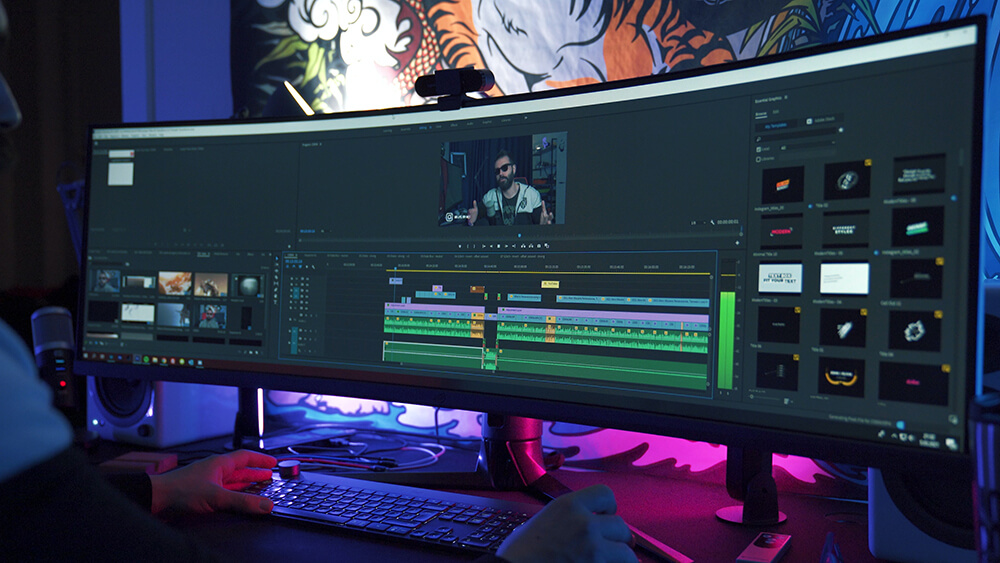Home / Handy Tips /

Building your own video editing PC may seem intimidating, but it offers significant rewards and the opportunity to customise your setup for optimal performance and efficiency.
Whether you have extensive editing experience or are just starting out, in this guide we walk you through 7 key elements to bear in mind in the building of a video editing PC.
1. Internal specifications
When it comes to video editing, your PC’s internal specifications – CPU, RAM and GPU – are really important.
The CPU is the brain of your computer. Choosing a powerful CPU with multiple cores will help your editing software run smoothly, especially when working on high-resolution or involved projects. For most users, 4 cores would be adequate with 6+ cores being more suited to complex projects.
RAM dictates how much data your system can handle at once, so having enough is key for multitasking and avoiding frustrating slowdowns. Ideally, including 32GB of RAM will allow you to edit a range of files and work with longer videos.
The GPU (Graphics Processing Units) can really speed up tasks like rendering and playback. There are a range of GPU solutions, including Asus that offers a range of graphics cards for your budget, catering for the professional editor to the home enthusiast.
With so many options available, choosing the right combination depends on your specific needs, budget and the software you plan to use.
2. Storage solutions
For storage solutions in a video editing PC, SSDs (Solid State Drives) stand out as superior to HDDs (Hard Disk Drives) due to their lightning-fast data access speeds, which reduce loading times and enhance the overall responsiveness of your video editing.
However, for heavy-duty editing tasks, the importance of SSDs goes beyond speed. Multiple SSD configurations become essential, as they not only give enough storage capacity but also allow for seamless handling of large video files.
The SATA drives on the motherboard of your computer will determine how many HDDs and SSDs can be connected. Most manage at least 6 although some allow up to 8, allowing for large amounts of data storage.
This type of setup not only ensures smoother editing but also reduces data bottlenecks that can affect your productivity.
3. Display quality
A high-resolution monitor with its increased pixel density, gives great detail, allowing video editors to check footage with precision and ensure seamless transitions.
Colour-accurate monitors offer an essential advantage by reproducing colours as they are meant to be seen, allowing for accurate colour correction and grading.
The combination of both high resolution and colour accuracy allows you to make confident decisions, producing content that meets the highest standards and resonates with audiences.
4. Software compatibility
Ensuring compatibility between your chosen hardware and the video editing software is very important.
It’s not just about having the latest and greatest components – it’s about making sure they work seamlessly together to give the best performance.
Check the system requirements of your chosen software and take note of the recommended specifications when investing in new components. This ensures that your hardware is not just compatible but also capable of harnessing the full potential of your editing software.
5. Peripheral enhancements
Peripheral enhancements can elevate the editing experience by adding in tools to streamline the creative process.
Secondary monitors provide an expanded workspace, improving multitasking and efficiency by allowing you to access more windows simultaneously.
Drawing tablets bring in a hands-on and precise way to work, perfect for fine-tuning edits and being creative with graphics.
They give a natural, pen-and-paper feel that’s just like the real thing. For those working with Apple products, the iPad Pro 2022 M2, for example, has fast performance and can manage large video files with ease.
By including peripheral enhancements, video editors can unlock new levels of creativity, efficiency and precision, ultimately resulting in a more immersive and productive editing environment.
6. Budget considerations
When building a video editing PC, it’s not just about the cost of hardware – it’s also about software expenses.
By carefully allocating resources, you can strike a balance between cost-efficiency and performance, ensuring that the editing setup is both effective and financially sustainable.
While it’s tempting to splurge on the latest and greatest components, prioritising spending based on your specific needs is key.
For example, if you work with high-resolution videos, you might want to focus on getting a strong CPU and plenty of RAM. But for 3D rendering tasks, having a high-quality graphics card could be your top priority.
7. Futureproofing
Futureproofing involves choosing hardware components and software solutions that can adapt to evolving industry standards and technologies.
For instance, investing in a high-quality CPU and sufficient RAM ensures that the system can handle upcoming software updates and more demanding projects.
Opting for versatile and expandable hardware configurations also allows for easy upgrades when necessary, extending the lifespan of the editing setup.
By adopting a forward-thinking approach and anticipating future demands, you can minimise the need for frequent overhauls and stay ahead in an ever-evolving technical world.
Need help with setting up your video editing PC?
Take your computing experience to the next level with Computer Cures’ upgrade service. Whether you’re looking for fast performance, seamless multitasking or enhanced creativity, contact us today and let us guide you on the best solutions.








Leave A Comment